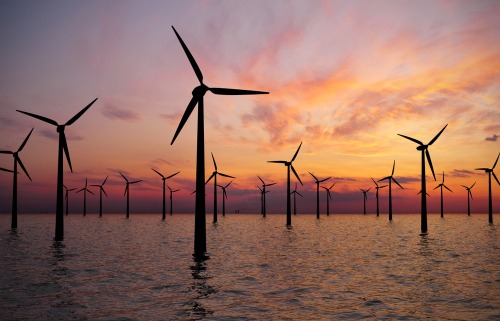DOE report says offshore wind pipeline has shown substantial growth

The U.S. offshore wind industry pipeline grew 24 percent in 2020 into early 2021 with 35,324 megawatts (MW) now in various stages of development, according to the Offshore Wind Market Report: 2021 Edition.
The report, authored by researchers at the U.S. Department of Energy (DOE) and its National Renewable Energy Laboratory (NREL), also said that the pipeline is expected to grow fuller with the Biden administration’s goal to deploy 30 gigawatts (GW) of offshore wind power by 2030.
Overall, 15 projects in the offshore wind energy pipeline have reached the permitting phase, while 16 commercial leases in federal waters have gained exclusive site control. Further, seven wind energy areas can now be leased at the discretion of the federal government and the Bureau of Ocean Energy Management (BOEM) has designated nine Call Areas—areas being considered for future offshore wind energy development.
The two largest projects in the pipeline include the 30-MW Block Island Wind Farm off Rhode Island and the 12-MW Coastal Virginia Offshore Wind pilot project. In addition, the 800-MW Vineyard Wind 1 project near Massachusetts recently became the first fully approved, commercial, offshore wind energy project in the United States.
The report also detailed that in addition to the Biden administration’s target of installing 30 gigawatts of offshore wind by 2030, states are aiming to procure at least 39,298 MW of offshore wind capacity by 2040.
It also revealed that an increase in the size of turbines is one of the main drivers behind lower offshore wind energy costs. Three leading turbine manufacturers, Siemens Gamesa, Vestas, and General Electric, are planning to make larger wind turbines.
“This report shows that the offshore wind market is on an upward curve, both nationally and globally,” Walt Musial, an NREL principal engineer and the lead report author, said. “Maturing technology and falling costs have driven that curve for several years, and today, we’re seeing a continuation of those trends. Here, in the United States, federal and state support are also adding momentum.”
The Offshore Wind Market Report provides information about the U.S. and global offshore wind energy industries to inform policymakers, researchers, and analysts about technology and market trends.
“Looking to the future, we expect offshore wind energy in the United States to expand beyond the North and Mid-Atlantic into the Pacific, Great Lakes, and the Gulf of Mexico,” Musial said. “That expansion means abundant energy at lower costs, job growth, and progress toward decarbonization. NREL will continue to leverage its expertise, world-class facilities, and industry, research, and commercial partnerships to help the United States lead the charge forward.”
